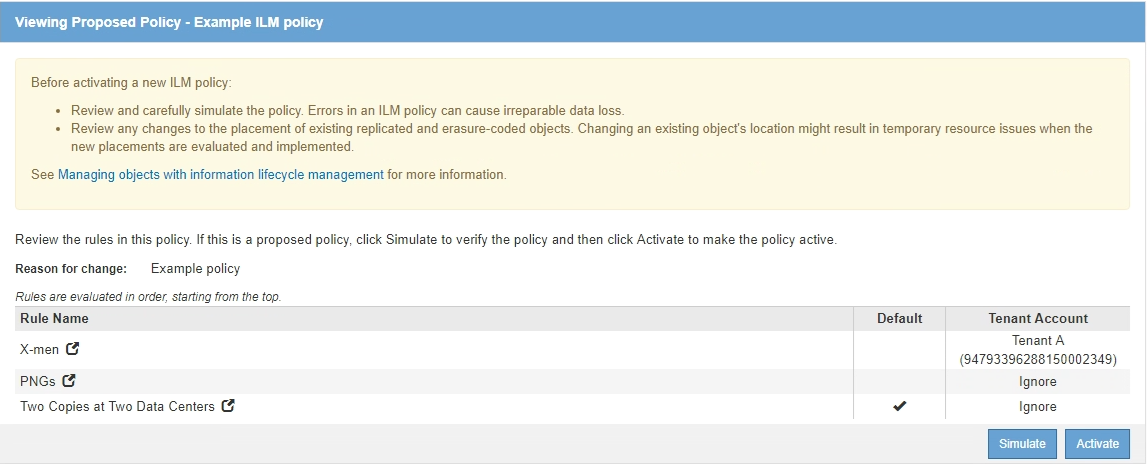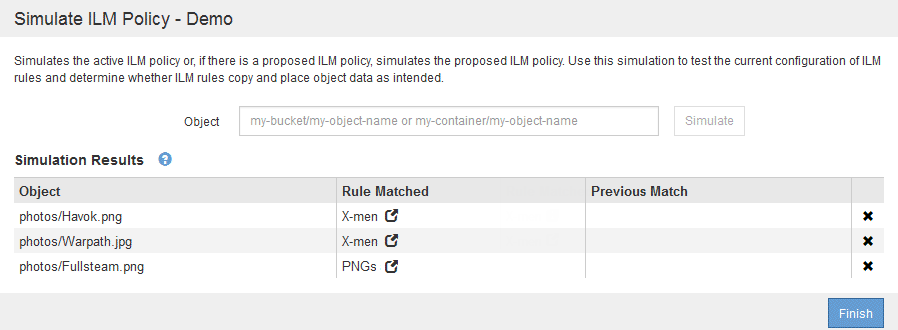Simulating an ILM policy
 Suggest changes
Suggest changes


You should simulate a proposed policy on test objects before activating the policy and applying it to your production data. The simulation window provides a standalone environment that is safe for testing policies before they are activated and applied to data in the production environment.
-
You must be signed in to the Grid Manager using a supported browser.
-
You must have specific access permissions.
-
You must know the S3 bucket/object-key or the Swift container/object-name for each object you want to test, and you must have already ingested those objects.
You must carefully select the objects you want the proposed policy to test. To simulate a policy thoroughly, you should test at least one object for each filter in each rule.
For example, if a policy includes one rule to match objects in bucket A and another rule to match objects in bucket B, you must select at least one object from bucket A and one object from bucket B to test the policy thoroughly. If the policy includes a default rule to place all other objects, you must test at least one object from another bucket.
When simulating a policy, the following considerations apply:
-
After you make changes to a policy, save the proposed policy. Then, simulate the behavior of the saved proposed policy.
-
When you simulate a policy, the ILM rules in the policy filter the test objects, so you can see which rule was applied to each object. However, no object copies are made and no objects are placed. Running a simulation does not modify your data, rules, or the policy in any way.
-
The Simulation page retains the objects you tested until you close, navigate away from, or refresh the ILM Policies page.
-
Simulation returns the name of the matched rule. To determine which storage pool or Erasure Coding profile is in effect, you can view the Retention Diagram by clicking the rule name or the more details icon
 .
. -
If S3 Versioning is enabled, the policy is only simulated against the current version of the object.
-
Select and arrange the rules, and save the proposed policy.
The policy in this example has three rules:
Rule Name Filter Type of Copies Retention X-men
-
Tenant A
-
User metadata (series=x-men)
2 copies at two data centers
2 years
PNGs
Key ends with .png
2 copies at two data centers
5 years
Two Copies Two Data Centers
None
2 copies at two data centers
Forever

-
-
Click Simulate.
The Simulation ILM Policy dialog box appears.
-
In the Object field, enter the S3 bucket/object-key or the Swift container/object-name for a test object, and click Simulate.
A message appears if you specify an object that has not been ingested.

-
Under Simulation Results, confirm that each object was matched by the correct rule.
In the example, the
Havok.pngandWarpath.jpgobjects were correctly matched by the X-men rule. TheFullsteam.pngobject, which does not includeseries=x-menuser metadata, was not matched by the X-men rule but was correctly matched by the PNGs rule. The default rule was not used because all three objects were matched by other rules.



